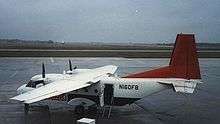Northwest Airlink Flight 2268
|
CASA 212 N160FB of Northwest Airlink at Flint Airport Michigan in April 1986 | |
| Accident summary | |
|---|---|
| Date | 4 March 1987 |
| Summary | Pilot error |
| Site | Romulus, Michigan |
| Passengers | 16 |
| Crew | 3 |
| Fatalities | 9 |
| Injuries (non-fatal) | 20 (10 on the ground) |
| Survivors | 10 |
| Aircraft type | CASA C-212 |
| Operator | Northwest Airlink |
| Registration | N160FB |
| Flight origin | Cleveland-Hopkins International Airport |
| Destination | Detroit Metropolitan Wayne County Airport |
Northwest Airlink Flight 2268 was a commuter flight between Cleveland-Hopkins International Airport in Cleveland, Ohio, and Detroit Metropolitan Wayne County Airport in Romulus, Michigan, just outside Detroit. The flight was operated by Fischer Brothers Aviation, doing business as Northwest Airlink, and was operated by a CASA C-212 aircraft. On March 4, 1987, the plane crashed while attempting to land. Nine of the 19 passengers and crew on board were killed in the accident.
Flight
At 2:30 p.m. after being cleared for a visual approach to Runway 21R and while just 60–70 feet above the ground, Northwest Airlink Flight 2268 banked left in a descent and then rolled right. The twin-engine turboprop aircraft struck the ramp area inside and to the left of the runway threshold, flipping over, and then striking a catering truck before bursting into flames.[1]
Nine of the 19 people on board the aircraft died. Both the pilot and co-pilot were killed in the crash. Autopsies determined the cause of death to be smoke inhalation and burns. Federal investigators said the nine victims may not have died if their seat cushions had been treated with fire retardant.[2] Ten people on the ground were also injured in the accident.
Investigation
The job of investigating the crash was made difficult due to the aircraft having neither a flight data recorder or cockpit voice recorder.[3]
Shortly after the investigation was started, it was learned the flight's pilot had been cited twice for unsafe flying. Records showed that the pilot had his license suspended for 15 days in 1979.[4]
The National Transportation Safety Board determined that the probable cause of the accident was "the captain’s inability to control the airplane in an attempt to recover from an asymmetric power condition at low speed following his intentional use of the beta mode of propeller operation to descend and slow the airplane rapidly on final approach for landing. Factors that contributed to the accident were an unstabilized visual approach, the presence of a departing DC-9 on the runway, the desire to make a short field landing, and the higher-than-normal flight idle fuel flow settings of both engines. The lack of fire-blocking material in passenger seat cushions contributed to the severity of the injuries."[5]
See also
Northwest Airlines Flight 255, another aviation disaster that took place at Detroit Metropolitan Wayne County Airport in 1987.
